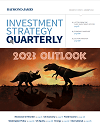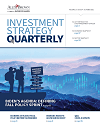The oil market is facing an unprecedented one-two punch, but director and energy analyst Pavel Molchanov envisions recovery by 2021.
Oil’s bear market dates back to February, with the clear culprit being the impact on global oil demand arising from the transportation and economic disruptions due to COVID-19. During January and February, COVID-19 had been seen as a problem largely contained within China. Throughout March, however, it became clear that the impact would be truly global in scope.
As the public health situation in China shows encouraging signs of stabilization, the opposite is true practically everywhere else. As governments impose flight restrictions and other travel bans, enforce lockdowns, and require non-essential businesses to close doors, the impact on oil consumption is unlike anything in modern history. Numerous airlines are reporting over 50% flight cancellations. With 800+ million students affected by school and university closures, that means many fewer buses and cars on the roads. Countless millions of people are working from home, due to government directives or company instructions. In the second quarter of 2020, the impact of all these disruptions is likely to exceed 5 million barrels per day (bpd), or 5% of global demand. Needless to say, the timing of improvement in demand, enabled by the easing of the various restrictions, will largely be a function of medical and public health developments vis-a-vis the virus. Assuming that this second quarter figure marks the peak of impact, we forecast global demand down 1.5 million bpd for 2020, steeper than the declines from 2008 and 2009 (the two financial crisis years) combined.
Oil price war
Sometimes, when it rains, it pours. Such is the case with the oil price war between Saudi Arabia and Russia, which emerged suddenly and dramatically on March 7, compounding the already ultra-bearish demand backdrop. These two countries had collaborated as part of the OPEC+ coalition over the previous three years, but no longer. Saudi Arabia is vowing to increase oil production to record levels in response to Russia’s refusal to cooperate with new production guidelines.
This price war, to be clear, is not against U.S. shale; this is a key contrast to the 2014-2016 price war. Saudi Arabia can see perfectly well what has been happening in the U.S. oil industry: depressed rig counts and sharply slowing production growth, even before the dramatic events of recent weeks. The Saudi Arabia vs. Russia fight is partly economic, and it is also political. Russia will have a major constitutional referendum on April 22, arguably the most sensitive moment in domestic politics during Vladimir Putin’s 20 years in power. In the run-up to the referendum, the Kremlin is stirring up nationalist fervor at home, and that translates into more intransigence than usual in foreign policy. Moreover, the Saudis and Russia have never stopped being at loggerheads over Iran and Syria.
Here is the good news: assuming that Putin wins the referendum, we anticipate that Russia will become more receptive to international deal-making, opening the door to an agreement with Saudi Arabia in May/June, followed by normalization of Saudi oil production. It bears mentioning that the Saudi economy needs $70 per barrel (Bbl) Brent crude to balance its all-in fiscal requirements. Moreover – and this is another big distinction versus 2014-2016 – Saudi Aramco (its state-owned oil company) is now publicly traded. Does the Saudi crown prince want to deal with angry domestic investors who are seeing losses from the IPO price? Again, this factor, a key test of the royal family’s credibility, did not exist four or five years ago. Russia’s economy is less oil-sensitive, but it would also begin to feel real pain within months. Thus, we look at this Saudi-Russia breakbup as a transitory issue.
Expect volatility
In the short run, oil market conditions will surely be volatile. The floor during the 2014-2016 oil down cycle had been set when numerous data points began to emerge about higher-cost/lower-margin oil producers physically shutting down wells. Plenty of the world’s oil trades at hefty discounts relative to the light sweet benchmarks, so the point at which marginal cost begins to exceed marginal revenue at certain oilfields is closer than it might seem at first glance. West Texas Intermediate (WTI) crude stayed under $40/Bbl for approximately 100 days (from December 2015 through March 2016). Its absolute bottom was $26/Bbl in February 2016. This time, the degree of oversupply is much worse, so it stands to reason that the trough will also be lower. We think that WTI will test the $20/Bbl level in the second quarter of 2020 – the lowest since 1999 – averaging $25/Bbl for the quarter. After that, we forecast a V-shaped bounce to $45/Bbl in the fourth quarter and then a slower recovery to an average of $55/Bbl in 2021.
Industry response
So, how is the oil industry handling this exceptionally difficult period? What practically every oil producer is currently focused on, as the first line of defense, is cutting capital spending. In many cases, they are cutting quite sharply, by 30% or even more, as compared to the initial budgets from January/February. Some reductions in corporate costs are also inevitable, and a limited number of companies will cut or suspend dividends. The main driver will be to slow drilling activity and postpone projects. By responding rapidly in this way, the large, investment-grade companies will be able to steer themselves through this period. In fact, they may even benefit – over a long-term timeframe – by taking advantage of this crisis as an opportunity to pick up cheap, distressed assets when some of the smaller players with excessive leverage end up going through bankruptcy.
Read the full April 2020
Investment Strategy Quarterly
Read the full April 2020
Investment Strategy Quarterly
All expressions of opinion reflect the judgment of Raymond James, and are subject to change. Investing involves risk including the possible loss of capital. Past performance may not be indicative of future results. Companies engaged in businesses related to a specific sector are subject to fierce competition and their products and services may be subject to rapid obsolescence.
Markets & Investing Members of the Raymond James Investment Strategy Committee share their views on...
Markets & Investing Review the latest Weekly Headings by CIO Larry Adam. Key Takeaways ...
Technology & Innovation Learn about a few simple things you can do to protect your personal information...

